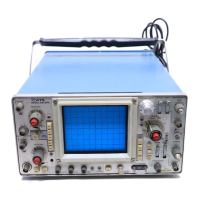TM 11-6625-2735-14-1
11. Hold the crt base socket away from the neck shield
To install the Delay Line, reverse the removal
and slide the shield to the rear of the instrument about
procedure. Use the Cathode-ray Tube Installation
2 inches.
procedure for installing the crt.
12. Pry the Multiplier jack from its mounting clip on the
main chassis.
13. Remove the High-Voltage Multiplier. If necessary,
carefully pry the Main Interface board away for easier
removal and guide the Multiplier jack through the main
chassis.
14. To install the High-Voltage Multiplier, reverse the
removal procedure. Use the Cathode-ray Tube installa-
tion procedure for installing the crt.
Delay Line Removal
1. Remove the cathode-ray tube as outlined previous-
ly.
2. Disconnect a two-wire cable near the rear of the
INTENSITY control (cable from y-axis alignment coil).
3 Remove a screw connecting a solder lug and heavy
braid from the Vertical Output board at the crt neck shield.
4. Remove one screw that holds the crt neck shield to
the black-plastic rear bracket.
5. Hold the crt base socket away from the neck shield
and remove the crt neck shield through the main chassis
rear opening, using care to guide the y-axis coil cable
through the board and chassis holes.
6. Remove the Keps nut and delay-line bracket holding
the Delay Line to the main chassis.
7. Disconnect the Delay Line ends at the Vertical
Preamp and Vertical Output boards. This may require the
use of a soldering iron (a 40 to 60-Watt iron works best).
8. Remove the Delay Line, using care to guide the
Delay Line ends through the main chassis holes without
causing sharp bends in the line.
Recalibration After Repair
After any electrical component has been replaced, the
calibration of that particular circuit should be checked, as
well as the calibration of other closely related circuits.
Table 4-5 lists the adjustments that may interact with a
repair in a particular circuit. The table is also useful as a list
of calibration adjustments that should be checked if an
adjustment is made when performing the Calibration
procedure. Perform a calibration check of each interac-
tion, using the appropriate step in the Calibration
procedure found in TB 11-6625-2735-35-1.
Instrument Repackaging
Save and re-use the package in which your instrument was
shipped. If the original packaging is unfit for use or not
available, repackage the instrument as follows:
1. Obtain a carton of corrugated cardboard having inside
dimensions of no less than six inches more than the
instrument dimensions; this will allow for cushioning.
Refer to the following table for carton test strength
requirements.
2. Surround the instrument with polyethylene sheeting to
protect the finish of the instrument.
3. Cushion the instrument on all sides by tightly packing
dunnage or urethane foam between carton and instru-
ment, allowing three inches on all sides.
4. Seal carton with shipping tape or industrial stapler.
SHIPPING CARTON TEST STRENGTH
Gross Weight (lb)
Carton Test Strength (lb)
0-10
200
10-30
275
30-120
375
120-140
500
140-160
600
4-32

